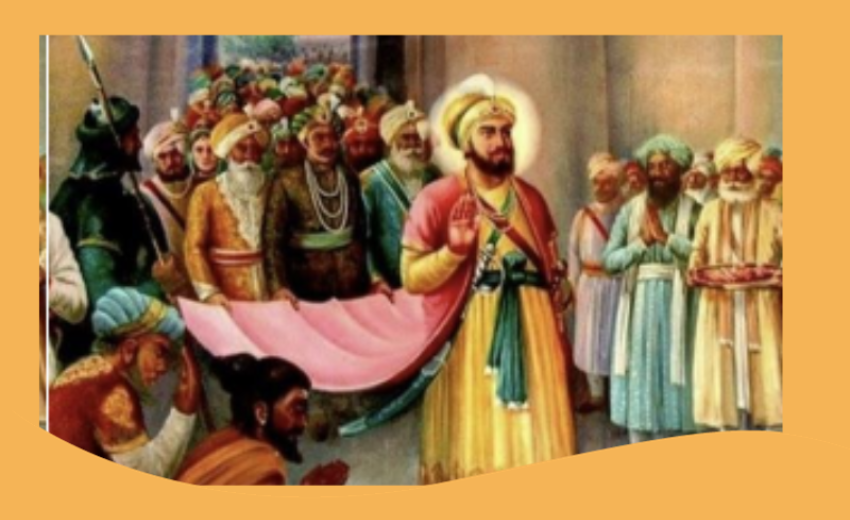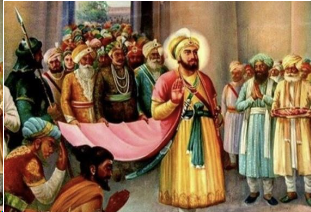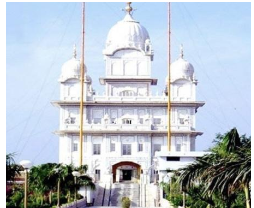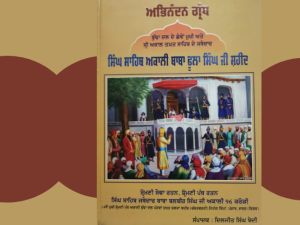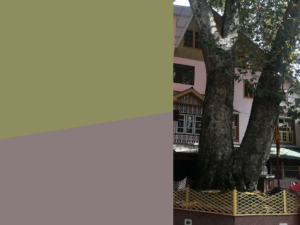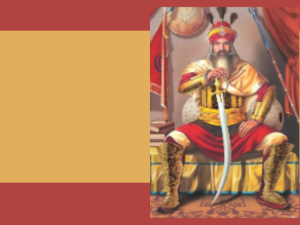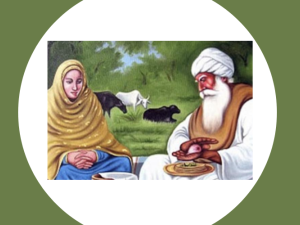The wisdom and precision with which Guru Hargobind Sahib converted the Sikhs into a military organization marks the beginning of an unprecedented chapter in the history of the world. Guru Hargobind's flamboyant lifestyle and Militarization, marked by warlike costumes and symbols of independence, drew Emperor Jahangir's attention and raised concerns of rebellion. Guru Sahib's transformation of Sikhs into a military organization and his various activities, including setting up courts, building Loh Garh fort, and conducting military exercises, further alarmed the emperor. Conspiracy by Hindu feudal lords against Guru Hargobind Sahib were another factor contributing to his detention in Gwalior Fort.
Guru Hargobind Sahib reached Delhi on 31 December 1612. Guru Sahib stayed at Gurdwara Majnu Tilla in Delhi. Guru Sahib one day on the invitation went along with Emperor Jahangir on the hunt. In the forests of Dolipur, Guru Hargobind Sahib hunted a lion in front of the emperor. Nowadays there is a Gurdwara 'Sher Shikar Sahib', which is 21 km from Agra. Only after this hunt, Guru Hargobind Sahib was detained in Gwalior Fort. It was here that King Jahangir ordered the arrest of Guru Sahib and was sent to the Imperial Jail in Gwalior Fort. In this prison, more than a hundred kings were detained.
Historians have offered different durations for Guru Hargobind Sahib's imprisonment, ranging from 40 days to 12 years. Zulfiqar Ardastani Sasni's account suggests that Guru Hargobind Sahib was sent to Gwalior Fort to collect a fine imposed on Guru Arjan, although Guru Hargobind Sahib had no direct involvement. Zulfiqar Ardastani, author of 'Dabistan-i -Mazahib' has written. "The Emperor sent Guru Hargobind to Gwalior Fort to collect from him (Guru Hargobind ) the balance of the fine imposed on Guru Arjan."
An important historical artifact is an inscription found in Gwalior Fort well. This inscription, with Persian characters, indicates that Guru Sahib's arrest took place in 1613 AD. A few years ago when the ancient well of the Gwalior Fort was cleaned, a stone slab was found on which these Persian characters were engraved:
"Yak Mard-i-Kamil Pir Hind, Shahsham Guru Nanak Hargobind Shah-an Shah Noor-un-Din Sultan Hind Jahangir Nazarband Kardand" (Sammat 1670 Bikrami Wazir Khan)
It is also clear from this inscription that Guru Sahib was arrested in 1613 AD. This well was repaired by Wazir Khan himself and Guru Sahib used to bathe with the water of this well (Ganglu) during his detention. Guru Hargobind Sahib spent nearly six years in Gwalior Fort. This extended period was marked by harsh conditions, shared by many other prisoners, including kings. Emperor Jahangir's absence from the region between September 1613 and January 1619 created an opportunity for Guru Hargobind Sahib's eventual release. Notable figures like Hazrat Mian Mir, Malika Noor Jahan, and Wazir Khan played roles in this process. Sikh warriors, including Bhai Gurdas, Bhai Budha, Bhai Ballu, Bhai Parana, Bhai Kirtiya and other Sikhs stayed in Gwalior. Many Sikhs traveled from Punjab to Gwalior and kissed the walls of the fort and returned back as mentioned in Persian Source.
"Dar-ai-hungama Masand- wa- Sikhan, Me Raftade-wa-Diwar kila ra Sajda me Kardand" (Dabistan-i-Mazahib)
Haridas Droga of Gwalior Fort , who had converted to Sikhism, was instrumental in the release process. He informed Guru Sahib about Emperor Jahangir's dream, leading to the king's decision to release Guru Hargobind Sahib. But the truth is that 101 kings were living in the Fort with Guru Sahib. where Hazrat Mian Mir went to give darshan around 16th February on Jahangir's request. Although there is no mention in Tuzake Jahangiri Bhattvahis clearly mentions, "On Fagan 1, 1676 Bikarmi (January 28, 1620), Baba Buddha, Bhai Gurdas, Bhai Balu Roy, Bhai Param Roy etc. met Jahangir near Goindwal”.
Hazrat Mian Mir and Jahangir Emperor met for the first time at Kalanaur . On Diwali 1619, Guru Hargobind Sahib was at the house of Nayak Haridas (Hariram). Guru Hargobind Sahib's release negotiations involved a condition that all the king's imprisoned with him in Gwalior Fort must be released as well. Wazir Khan brought this condition to Emperor Jahangir, who agreed to release short-term prisoners (51) and allowed long-term prisoners 52 in number to come out by holding the buds of Guru Sahib's robe, that is why Guru Sahib is known as Bandhi Chod Datta. Guru Hargobind Sahib was released from Gwalior Fort on October 26, 1619, as documented in Bhattavahis. This release is mentioned in the Bhattavahis,
"Guru Hargobind Ji Mahal Chhata Beta Guru Arjan Ji Ka, Sodhi Khatri Chak Guru Ka Pargana Nijharala, Samat Solan Soo Chihatra Katak Mase Krishna Paksha Chaudas Ke Dien Guru Ji Bawan Rajyo Ke Gal Gur Gwalior Se Bandhan Mukat hoe."
Naik Haridas Droge, son of Harbans Lal, Chandra Bansi Jadav, Barhtii Kanawat lit Deepmala in the whole house as a joy for the release of Guru Hargobind Sahib from prison. After staying for a day at the house of Haridas (Hariram), Guru Sahib left Gwalior and reached Agra, where he interacted with EmperorJahangir and others. Although it is not mentioned in Tozake Jahangiri, according to the Bhattvahis, Guru Sahib and Jahangir reached Kalanaur (near Batala) on 8th February 1620 and stayed for about 15 days. Guru Hargobind Sahib's journey back to Punjab involved various interactions and significant events. He resumed religious and military activities among Sikhs, and there was a renewed sense of enthusiasm and unity among the Sikh community.
On 28 December 1620, Guru Hargobind Sahib came to Guru's Chak (Amritsar). The Sikh Sangat offered Deepmala when Guru Sahib came to 'Guru di Nagri' Amritsar. Guru Sahib started military training and religious preaching tours for the Sikhs. After the release of Guru Sahib, there was a new enthusiasm among the Sikhs, and they were ready to die for the Guru. King Jahangir was also determined to maintain friendship with Guru Sahib for the rest of his life. The influence of Sheikh Ahmad Sarhandi (who had written a letter to Jahangir exulting in the martyrdom of Guru Arjan DevJi ) lost its influence on Jahangir and Jahangir arrested Sheikh Ahmad Sarhandi in July 1619 and imprisoned him in the Gwalior fort.
Jahangir himself revealed Chandu's conspiracy behind Guru Arjan Sahib's martyrdom and handed over Chandu and his family to Guru Sahib. At the request of Guru Sahib, the brave general Bidhi Chand left Chandu's wife and children. Bhai Bidhi Chand put a nickel (Iron hook) in Chandu's nose and dragged him behind a horse with a chain. When Bidhi Chand came near Gurditte Bharabhunje's shop, he lashed out and beheaded Chandu on the spot. It should be remembered that Chandu poured hot sand on Guru Arjan Dev Ji's forehead from this Bharabhnje. Jahangir came to visit the Darbar Sahib and Akal Takht Sahib offered 500 seals and bowed down. It was proposed to do the repair work of the Akal Takht Sahib from the royal treasury, but Guru Sahib said,
“ਕਹਾ ਗੁਰੂ ਅਬ ਯਹੀ ਸੁਹਾਵੈ, ਸਮਾਂ ਪਾਇ ਇਹ ਅਧਿਕ ਬਨਾਵੈ?” (ਗੁਰਬਿਲਾਸ ਪਾਤਸ਼ਾਹੀ ਛੇਵੀਂ)
Dr Ganda Singh also embodied this point in his “A Short History of the Sikhs."

